Back to Nature

In the quaint town of Danville, Pennsylvania, lies a gem of a home theater owned by Rhonda and Robert Seebold. While their 9,000-square-foot home is located in an exclusive development, they are situated on the top of a hill, which gives them access to several acres of pristine woodlands right in their backyard. It also gave Rhonda a private area in which to develop an award-winning water garden, which includes two streams, a waterfall, and a pond with koi fish.
The Seebolds contracted Al DeGaetano, CEO of Futureview TV Services in Elysburg, Pennsylvania, not only to build a home theater on the lower level, but also to design, build, and install a lobby, kitchenette, bar, and butler's pantry outside the theater. Inspired by Rhonda's water garden and the gorgeous woodland-retreat view from the lower level, DeGaetano decided that he would draw the outdoors in and infuse that serenity into the home's lower level.
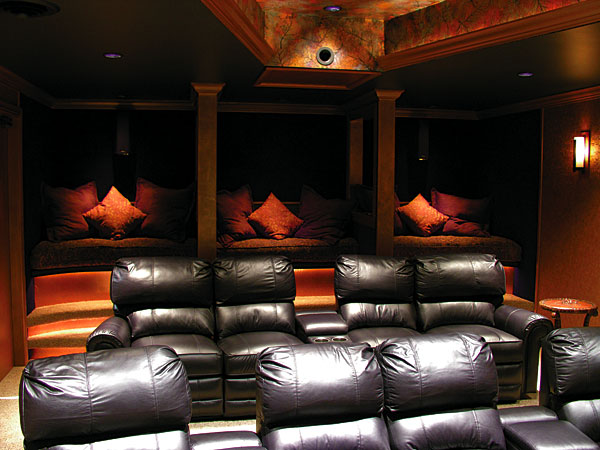
The lower level was already remodeled, and the previous architects had left a space for a media room. Chagrined, Rhonda showed DeGaetano the designated room layout, which was not much bigger than an 8-by-10-foot broom closet. "This is indicative of the attitude toward home theater today," says DeGaetano. "A pool can cost tens of thousands of dollars, only be used for three months out of the year—especially in Pennsylvania—and take up someone's entire backyard. But many people aren't willing to invest the money or space for a home theater, which they will use each and every day, making their investment literally pennies a day."
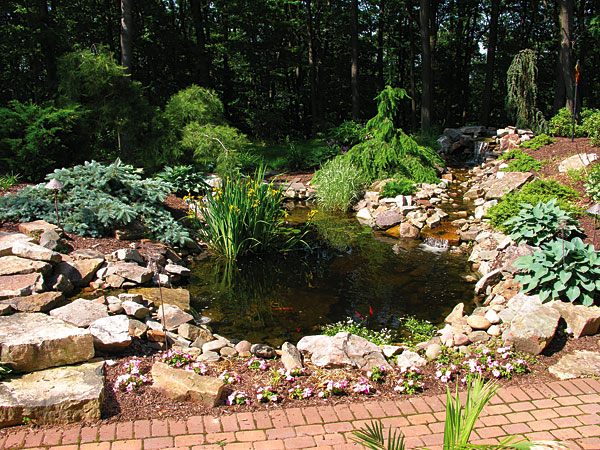
DeGaetano urges potential clients not to think of home theater as just installing a new TV or sound system into the home, but as undertaking a home-improvement project. "Part of our educational process in this industry is to redefine home theater as controlling your environment and integrating your sources. We don't think that way with TV yet," says DeGaetano. "But installing a theater without thought to the environment is like asking Rhonda to grow her water garden on the interstate. It's the same for home theater. Why buy good equipment and not control your environment? Home entertainment is currently the number-one activity for families. Why not do it in a proper way?"
Luckily, the Seebolds subscribed to DeGaetano's views on the subject and wanted to do the theater right. Next to that small broom closet originally designated for the theater, there was an unfinished storage room that could serve as the home theater. It wasn't quite big enough, so DeGaetano and his team extended the home theater back another 4 feet into the broom closet to make it more spacious.

But this proved to be problematic. Once they examined the rear wall with the drywall removed, Futureview realized that this load-bearing wall didn't have enough support. A couple of two-by-fours were bowing under the weight. This was a fortunate discovery for the homeowners. After they removed the wall, they installed posts and beams, which created design issues in the theater.
Futureview made lemonade out of lemons by incorporating these new structural elements into the theater with a creative three-bench seating structure at the rear of the room that curves along the back wall. "This really turned out well," says DeGaetano. "It sets off the room, and the benches are comfortable and welcoming." Now the theater dimensions are roughly 16 by 26 feet with three tiers of seating and an open, comfortable feel.

To bring a naturalistic element into the theater, DeGaetano thought of the stone pillars on the screen wall. "There is usually a dead zone between the screen and the first row of seats. We like to fill that dead zone with a platform and a stage, and the stone pillars really helped to enhance the structure," says DeGaetano. (Note the indirect lighting on the stonework below the screen, which gives the stone a great shadowing effect.) Another interesting element is the media racks at the front of the room, which house the homeowners' extensive music and movie collection.
For the equipment rack, Futureview takes a different approach than many installers, who like to hide it away. "We do our own custom cabinetry and always include accessibility from behind," says DeGaetano. "We don't subscribe to the philosophy that gear should always be hidden. People like to play with and see their toys but not be distracted by them. You also often need access to devices such as DVD players," he comments.
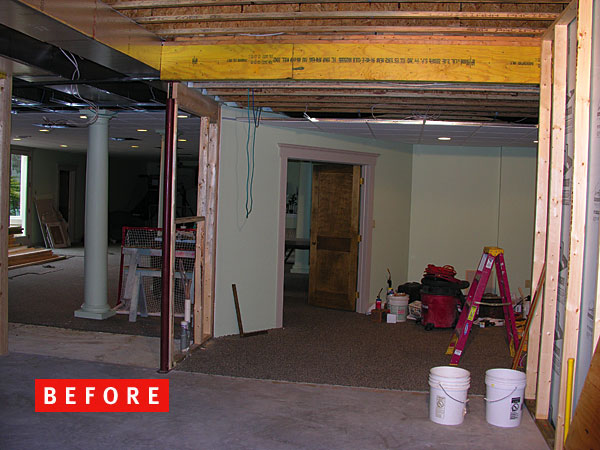
The rack in the Seebolds' theater houses some fine gear, including a Denon DVD player and processor and a Panamax MAX 5300 surge protector/line conditioner. An HD Motorola DVR cable box provides another viewing source. Meanwhile, a 7.1-channel Definitive Technology speaker system handles immersive audio in the theater. The system consists of two BP7001SC fronts, one C/L/R 2500 center, and four BPX surround speakers, aided by Acoustiblok acoustic treatment to tame room reflections.
A Runco VX-1000ci projector is installed in a climate-controlled hush box on the ceiling, and a Stewart Filmscreen FireHawk screen resides in a custom velvet-lined shadowbox. Together, they provide an exceptional image. The Philips iPronto Tsi 6400 controller lets Rhonda, Robert, and their two children, Rob and Dan, operate the theater with ease.
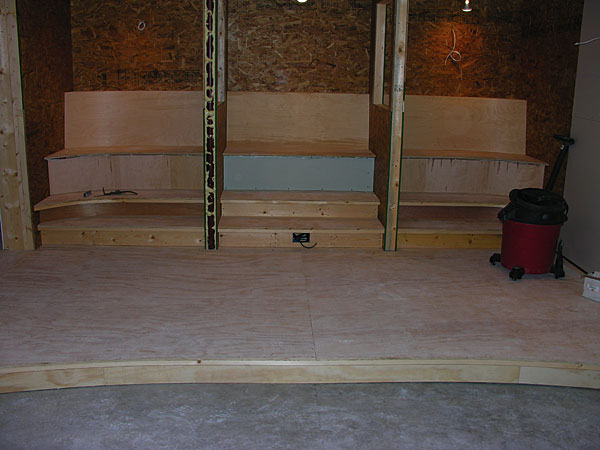
Outside the theater, as you enter the home's lower level from the water garden, you come upon the bar area and, behind that, the kitchenette. To the right are double doors that lead to a small exercise room (the remnants of the original designated space for the theater), and to the right of that are the butler's pantry and the home theater lobby. The lobby features a gorgeous waterfall at the entrance, again bringing the naturalistic theme indoors. The theater remote controls all of the lighting, as well as the waterfall. If the waterfall is on, come in and be seated; if the waterfall is off, viewing is in progress.
Part of DeGaetano's unique business model is not only vertically integrating his company so that Futureview can serve as a one-stop shop for building a home theater, but also working directly with the females of the household. "I'd say, on 80 percent of the projects we undertake, we work primarily with the woman of the household," says DeGaetano. "That's why, in our showroom, we show movies like Under the Tuscan Sun and Chocolat. When we show folks what they are missing, it's a revelation. It's like telling someone how an orange tastes versus peeling one for them and letting them experience it firsthand." According to DeGaetano, every artist needs a patron, and working with Rhonda on a lot of the ideas that are incorporated into the theater was a great experience. "It was one of those projects where you are sad when it's over." Rhonda and Robert certainly feel differently, as now they have a gorgeous, organic room that is easy to use and comfortable—and that they will enjoy for years to come. It was an investment well worth the time, money, and effort.
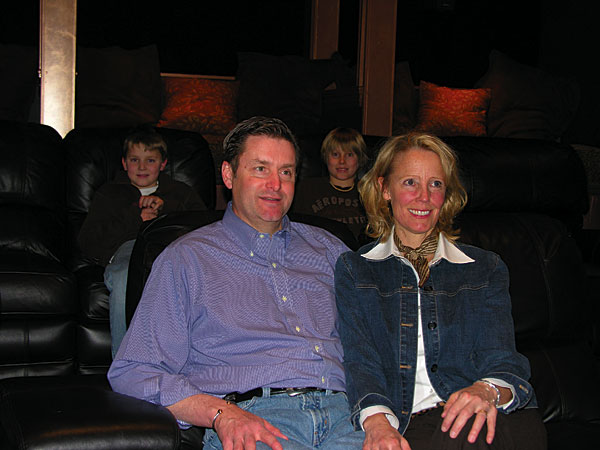
Why Is That Center-Channel Speaker on the Floor?
While the speaker appears to be on the floor—which isn't the optimal placement for a center-channel speaker—it is actually on the stage, about 10 inches off the floor and only 18 inches from the bottom of the screen. DeGaetano opted not to place the Definitive Technology center behind the screen due to space constraints and its high-watt woofer, which may have caused problems if it were enclosed. "Dead center behind the screen would be ideal placement, but maintaining the center axis is the most important thing," says DeGaetano. "Building the speaker into the wall right below the screen would offer minuscule sound improvement compared to the aesthetic compromise of the beautiful stone wall, not to mention the cost." To eliminate any frequency bias from the stage itself, DeGaetano acoustically treated the stage area with Acoustiblok and major insulation. The speaker is also tilted up and elevated slightly off the stage carpet.
- Log in or register to post comments




































































